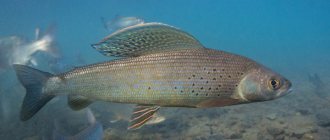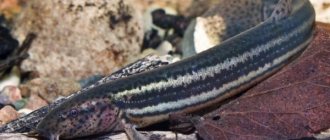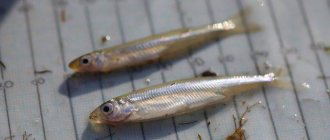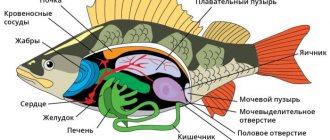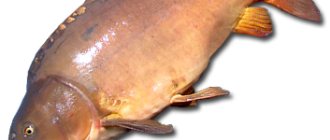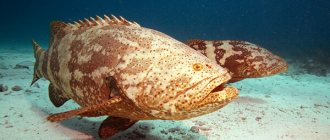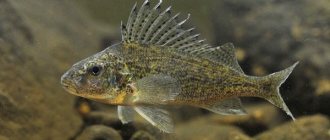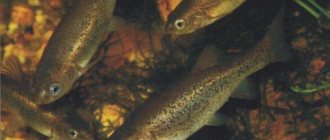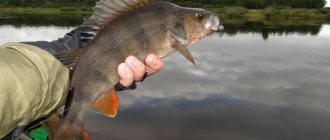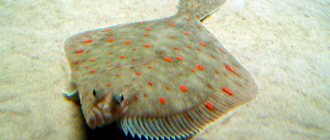Description
It can grow up to 20 centimeters in length. It has a relatively large head, which is somewhat wider than the body itself. It is distinguished by a large mouth and massive lips, as well as large eyes with a red tint. There are no scales on the body, but to protect against enemies, small but quite sharp spikes are placed throughout the body. In this regard, few predators will dare to feast on such prickly prey.
It has elongated pectoral fins covered with small dark spots. In the area of the gills there are protective scutes covered with the same prickly spines. The sculpin's back is gray-yellow with brown spots and stripes. This allows the fish to remain unnoticed against the background of stones, which is an effective protection against its natural enemies.
Leonid Pavlovich Sabaneev
Rice. 29. Sculpin
This original fish is easily distinguished from others by its huge, wide, rather flat head, armed on each side with a curved spike. Its body is completely naked, its eyes (red) are almost completely turned upward, the pectoral fins are very wide and long. The back is pale grayish, dotted with numerous dark specks and spots, which almost always form more or less wide transverse stripes; the belly is whitish or yellowish, sometimes with gray speckles; the fins, with the exception of the ventral ones, and even then not always, are mottled with gray spots. However, both in terms of color and body composition and the development of the head spines and individual fins, the sculpin is subject to many changes, depending on local conditions. Between these differences we quite often encounter the so-called. a narrow-mouthed goby (Cottus microstomus), distinguished by a narrower head, a smaller mouth and a very thick tail part of the body, and a multi-finned goby (Cottus poecilopus) with elongated ventral fins and, moreover, mottled with regular blackish (6-7) transverse stripes. As Blanchard notes, large bulls are always darker than young ones and have a wider head (especially males); females are always larger than males and are distinguished, especially during spawning, by their potbelliness.
Sculpins are very rarely more than 4 to 5 inches long; especially large ones are found in Chusovaya and Beloozero, where they sometimes reach up to 6 inches. They are found in almost all European countries, however, more in the northern ones, up to 66° N. sh., also in Western Siberia. It is very strange, however, that I did not find the sculpin in the Trans-Ural rivers. On the western side of the Urals, on the contrary, it is very numerous. In the lower reaches of the Volga and generally in the estuaries, the goby is rare, however, more because it loves fresh water and a rocky bottom. In central and northern Russia, it is found in very small streams, even in lakes with cold running water (for example, in Beloozero, in Lake Ostrovito Sebezhsk near Vitebsk province and others). In Turkestan it was found only in a tributary of the river. Chirchik is generally being replaced by another closely related species, but has not yet been seen in Transcaucasia. In Western Europe, the goby is considered a companion of trout and one of the main destroyers of its eggs. He always stays under stones, which is, of course, where his names came from - sculpin, podplnik, or he digs holes for himself in the sand - pechurki, hence the southern Russian name pechkur. In general, the sculpin does not like deep places and therefore is most often found in shallow places and near the coast. However, he mostly stays alone and is never noticed by even small flocks.
The goby constantly sits, hidden under stones, and swims very rarely, for short distances and certainly along the bottom, generally leading a sedentary lifestyle, but in a moment of danger and chasing prey, it turns out, although for short distances, to be very agile, and this agility, according to -apparently, it depends most of all on the strong development of the pectoral fins. But he has few enemies; Moreover, thanks to its nimbleness, secretive lifestyle and spiny scutes on the gill covers, the sculpin rarely falls prey to predators, most often trout. He himself is very voracious, feeds mostly on various crustaceans, water woodlice, larvae of water beetles and dragonflies, but is not averse to profiting from frog and fish eggs, as well as young fish, which is why in the West it is considered very harmful to waters inhabited by trout. Large bullheads even catch minnows and small minnows, which are almost always found with them.
The spawning behavior of the sculpin is quite remarkable, but has not yet been fully studied. It is one of the few fish that make something like a nest for themselves and in which the male plays a more important role than the female. Before spawning, which begins at
Habitats
Sculpins are widespread throughout Europe, Asia and North America. Fish prefer clean lakes, fast-moving rivers, as well as small streams where there is a fast current.
Representatives of the species live mainly in reservoirs with a rocky bottom. The species needs an abundance of oxygen and a low ambient temperature. Therefore, these fish prefer to leave warm bodies of water.
Lifestyle
The common sculpin is a fish that likes to stay away from other creatures. Representatives of the species choose a certain territory, which they zealously protect from the encroachments of their relatives. Fishes lead a solitary lifestyle. They migrate over short distances subject to a radical change in environmental conditions.
In the daytime, the common sculpin prefers to hide under stones, merging with the substrate. With the onset of dusk, it begins to forage for food. The fish is quite lazy. The sculpin swims little, trying to wait for prey while remaining motionless. However, at the first danger, it radically changes its behavior, developing enormous speed in a matter of moments. True, the sculpin swims not far away. The nearest stone or depression in the ground usually becomes a new hiding place for the fish.
Nutrition
The common sculpin is a skilled hunter. Before lying in ambush, waiting for potential prey to approach, the predatory fish stirs up the water with its powerful pectoral fins. Clouds of silt that rise from the bottom cover the body of the sculpin and at the same time attract the attention of other creatures. As soon as the prey approaches such cover, the predator makes a lightning-fast lunge with its wide mouth. What does the common sculpin eat? The predator's daily diet includes the following: Tadpoles. Insect larvae. Caviar of fish and frogs. Fry. Small fish.
Reproduction
The mating season for the sculpin begins in March. Males prepare in advance for reproduction by creating a small hole in the soil. Here males wait for females. At the same time, sculpins often enter into battle with other representatives of the species, zealously defending such a unique nest.
After fertilization, the female lays several hundred eggs in the hole and then swims away. The male remains in place, protecting future offspring. The maturation of the embryos in the eggs continues for a month. During this period, the male periodically clears the clutch of silt, actively working with his fins. As soon as the babies are born, the caring dad immediately leaves the nest. After birth, young individuals begin to actively search for food. At first, their prey is the eggs of frogs and other fish. Having gained mass, the fry hunt invertebrates.
Natural enemies
The sculpin is a traditional prey for other, larger predatory fish. Pike and perch like to hunt representatives of the species.
Also, the sculpin often becomes prey for grayling and burbot. Some mammals feed on this fish, in particular otters and minks. As for humans, fishermen prefer to send a sculpin caught in a net or on a hook back into the reservoir. After all, the size of the fish is very small. In addition, sculpin meat has a distinct muddy aroma. When eaten, the fish is not very tasty.
Keeping in an aquarium
The sculpin is extremely rarely kept in aquarium conditions. This is primarily due to the poor survival rate of the fish at the slightest change in environmental conditions. In order for a small predator to feel good in captivity, you have to regularly change the water in the aquarium, as well as constantly saturate it with plenty of oxygen. For this, a special injector must be used. It is necessary to create a shelter for the fish in the aquarium. You can build it from a pile of stones or driftwood.
During the first few days, the sculpin may be constantly in the shelter, refusing food. However, having become accustomed and hungry, the predator will greedily pounce on the offered food. As the latter, you can use insect larvae, bloodworms, and earthworms. Sculpins reproduce quite well in aquarium conditions. The first offspring can be expected within a month after the male and female are placed in an artificial pond. It is advisable to have a minimum number of males in the aquarium. Otherwise, aggressive manifestations and constant struggle for territory cannot be avoided. If the above conditions are met, the sculpin can exist in an aquarium for 5-6 years.
Observations in the aquarium
Frankfurt researcher Frenkel was able to observe the behavior of a species such as the common sculpin in an aquarium. He caught several representatives of this family of fish in a stream and placed them in an aquarium 120 x 50 x 40 cm. It could hold 20 buckets of water.
The soil was made of sand 5 cm thick. In some places, smooth stones were placed in groups at the bottom. The vegetation was represented by water moss and Vallisneria bushes.
The researcher carried out ventilation and air enrichment artificially using an injector.
When the fish were placed in this ecosystem, each large individual took its place near one of the piles of stones and began to guard its territory. They aggressively drove everyone away from her. The small fish tried to stay together.
For the first two days, the sculpins got used to the new conditions. And starting from the third day, they were offered food in the form of earthworms and enchytraea. The fish attacked the food greedily, catching it in flight and collecting it from the bottom.
Twice a week, 5 buckets of water were taken from the aquarium and new water was added. It was noted that the common sculpin felt good under these conditions.
Economic importance
People do not eat the common sculpin as food, since the fish is small in size and its meat is not tasty. But in nature, the common sculpin plays a very important role in the nutrition of such predatory fish as:
- Pike.
- Perch.
- Burbot.
- Grayling.
In addition, some animals such as otters, minks, mergansers and dippers feed on this fish.
At the same time, the sculpin is common in the northern part of Russia.
Economic importance of fish
People do not eat the common sculpin as food because the fish is small in size and its meat is not tasty. But in nature, the common sculpin occupies an important place in the diet of such predatory fish as:
- Pike.
- Perch.
- Burbot.
- Grayling.
Also, some animals such as otters, minks, mergansers and dippers feed on this fish.
Along with this, the sculpin is common in northern Russia.
Special status
This type of fish, which prefers clean waters with a high oxygen content, does not adapt well to heat and water pollution. Due to the fact that rivers are being polluted at a high rate, the number of sculpin is also decreasing. Considering that this fish plays a huge role in the food chain of many fish species, one can only imagine how serious the disappearance of this fish could be.
When the ambient temperature rises, the sculpin leaves or disappears from many bodies of water. The population of this unique fish is recovering very slowly, over several seasons. In this regard, this fish is listed in the Red Book of Russia and is classified as a rare fish species.
Despite some facts, sometimes this fish is caught by amateur fishermen. Due to its amazing coloring, the common sculpin is difficult to notice against the background of the bottom. He can rightfully be called a master of disguise, which often saves his life. But due to the fact that reservoirs are constantly polluted and water temperatures rise above normal, the sculpin is constantly disappearing from many reservoirs.
Special status of the common sculpin
This type of fish, which prefers clean waters with a high oxygen content, does not adapt well to heat and water pollution. Due to the fact that rivers are being polluted at a high rate, the number of sculpin is also decreasing. Considering that this fish plays a huge role in the food chain of many fish species, one can only imagine how serious the disappearance of this fish could be.
When the ambient temperature rises, the sculpin leaves or disappears from many bodies of water. The population of this unique fish is recovering very slowly, over several seasons. In this regard, this fish is listed in the Red Book of Russia and is classified as a rare fish species.
Despite some facts, sometimes this fish is caught by amateur fishermen. Due to its amazing coloring, the common sculpin is difficult to notice against the background of the bottom. He can rightfully be called a master of disguise, which often saves his life. But due to the fact that reservoirs are constantly polluted and water temperatures rise above normal, the sculpin is constantly disappearing from many reservoirs.
Sculpin goby, Kama River
In the Red Book of Russia
Despite the fact that this species is widespread throughout almost the entire territory of Russia, its numbers are declining everywhere. The common sculpin is very sensitive to various types of pollution. Therefore, it may well be an indicator of water purity. If you manage to meet this fish in a stream or lake, know that the pristine purity of nature is still preserved here. The common sculpin does not have any particular commercial significance, but because of its extraordinary appearance it is caught by amateur fishermen everywhere.
Common sculpin, sculpin goby (Pskov region)
Common sculpin, sculpin goby (Pskov region)—Cottus gobio Linnaeus Order Scorpaeniformes Family Kerchakovae—Cottidae Category, status. 3 - a vulnerable, small species found everywhere in water bodies of the Pskov region.
Included in the Red Book of the Russian Federation, 2 - a widespread, declining species, in the Red Books of the Leningrad Region, Estonia. Short description. Length 8–12 cm. Head flattened, body naked. Two dorsal fins. The pectoral fins are wide and fan-shaped. The color is grayish or light brown with dark spots, the belly is light gray. The pelvic fin ray makes up more than half of the body; the ventral fins lack dark transverse stripes. Pelvic fins do not reach the anus
Area and distribution. The entire European part of Russia, with the exception of the rivers of the Kola Peninsula (2). On the territory of the Pskov region it is found in almost all mesotrophic lakes, as well as in the rivers Plyussa, Zhelcha, Velikaya, Ushcha, Usvecha and in most of their tributaries that have a constant flow (without freezing of the riverbed in winter and drying out of the riverbed in summer), in the river. Sitnya (tributary of the Shelon river), river. Zhelcha, Velikaya river with tributaries, river. Fish with tributaries. It is a bottom-dwelling solitary fish, particularly in the river. Kudeb per 100 m of the channel (area of the village of Lysy-Mukhi), 10–12 gobies were found; in lakes, the largest number of sculpin gobies were noted in Lake Alyo (Bezhanitsky district) and Kamennoe (Opochetsky district), where per 1000 m of the shoreline (up to depth 1.0 m) under driftwood and stones was discovered in 1992–1996. 4–6 specimens of sculpin goby (1).
Habitats and biological features. It lives mainly in sections of rivers with sandy-stony soil and in the coastal zone of mesotrophic lakes, rarely in eutrophic lakes. Puberty at 2–4 years. Spawning occurs in late April - May, at water temperatures of 6–12 0C. The eggs are laid in a prepared nest that looks like a hole. The nest is guarded by the male. Fertility up to 3 thousand eggs. The larvae hatch in the spring, at water temperatures above 10 0C. The basis of its diet consists of invertebrates (mainly insect faces); it feeds on fish eggs, larvae, and fry. It has no commercial significance and is not an object of fishing for amateur fishermen (2).
Species abundance and limiting factors. Pollution and littering of watercourses, including spawning areas.
Security measures. Providing habitat conditions for the sculpin by improving the ecological condition of reservoirs.
Sources of information: Red Book of the Pskov Region 1. Alexandrov, author’s data; 2. Berg, 1948-1949. Compiled by: Yu. V. Alexandrov.
AOF | 01/30/2019 12:22:19
